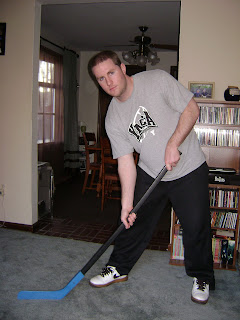Stand with your skates shoulder width apart and have your lead shoulder (the shoulder you're about to hit your opponent with) lower then your back shoulder.
Shoulder Joint- Sinister-Isometric Dexter-Isometric
Shoulder Girdle- Sinister-Isometric Dexter-Isometric
Elbow- Sinister-Flexion Dexter-Flexion
Radioulnar Joints- Sinister-None Dexter-Pronated
Wrist-Sinister-Isometric Dexter-Isometric
Hand-Sinister-Isometric Dexter-Isometric
Checking Prep Stance PhaseStand with your skates about shoulder width apart. Begin to lower the front shoulder and have your back skate with the tip of the toe on the ice and the heel of the skate in the air.
Shoulder Joint- Sinister- Extension Dexter-Flexion
Shoulder Girdle- Sinister-Abduction Dexter-Adduction
Elbow- Sinister-Extension Dexter-Flexion
Radioulnar Joints- Sinister-Pronated Dexter-None
Wrist- Sinister-Adduction Dexter-Abduction
Hand- Sinister-Flexion Dexter-Flexion
Checking Movement Stance Phase
Balance with your front skate on the ground and your back skate in the air. Skates should be a little wider than shoulder width apart. As you brace for impact your front shoulder should still be lower then your back shoulder and your back skate should be in the air, while your front skate remains totally on the ice.
Shoulder Joint-Sinister-Extension Dexter-Flexion
Shoulder Girdle- Sinister-Abduction Dexter-Adduction
Elbow- Sinister-Flexion Dexter-Flexion
Radioulnar Joints- Sinister-None Dexter-None
Wrist- Sinister-Aduction Dexter-Abduction
Hand- Sinister-Flexion Dexter-Flexion
Checking Follow-Through Stance Phase
Your skates should be shoulder width apart. Both skates should be back on the ice and your front shoulder should still be slightly lower then your back shoulder.
Shoulder Joint- Sinister-Extension Dexter-Flexion
Shoulder Girdle-Sinister-Abduction Dexter-Adduction
Elbow- Sinister-Flexion Dexter-Extension
Radioulnar Joints- Sinister-None Dexter-None
Wrist- Sinister-Isometric Dexter-Isometric
Hand- Sinister-Adduction Dexter-Abduction
Checking Recovery Stance Phase
Skates shoulder width apart and both skates should be back on the ground. Shoulders should be at same level and you should be ready for a pass, shot, or to check another player.
Shoulder Joint- Sinister-Flexion Dexter-Extension
Shoulder Girdle-Sinister-Adduction Dexter-Abduction
Elbow- Sinister-Flexion Dexter-Extended
Radioulnar Joints- Sinister-None Dexter-None
Wrist- Sinister-Isometric Dexter-Isometric
Hand- Sinister-Isometric Dexter-Isometric
Checking Video
Description: The person will begin by raising their stick in the air to about waist level. Once the hockey stick is at the waist level the person will then begin to lower their shoulder and brace for impact. The person will release their back skate off the ground and move their shoulder forward into the other person. While doing this their back skate will move closer to their front skate and the back skate will return to the ground. The person will then bring their stick back to the ground and get ready for a pass or a shot.
TERMS FOR "CHECKING"
Ice Skates- The shoes that are on a hockey players feet. The shoe is fitted with a metal blade in order to skate on the ice.
Hockey Stick- The stick that the hockey players use to shoot or pass the puck.
Shoulder Pad- The padding that is under the players jersey on top of his shoulder. This enables less impact when one player checks another player
DRILLS
In order to make sure you are doing this dril correctly make sure you are sitting with your back flat against the back of the chair and that both feet are flat on the ground. If you are doing the shoulder press standing up make sure your feet are flat on the ground and that your back is straight. You want to make sure you do not try to lift too much weight and that you fully extend your arms when lifting the weights or bar above your head.














